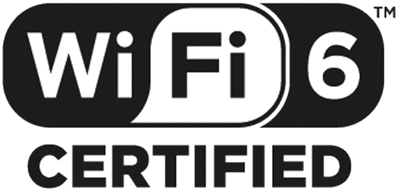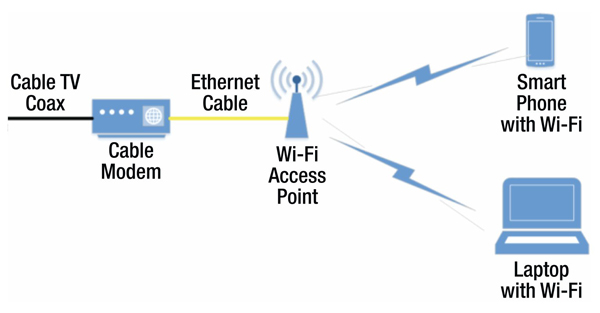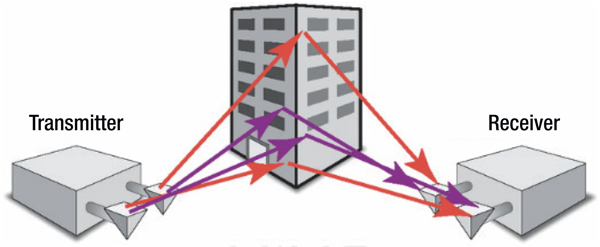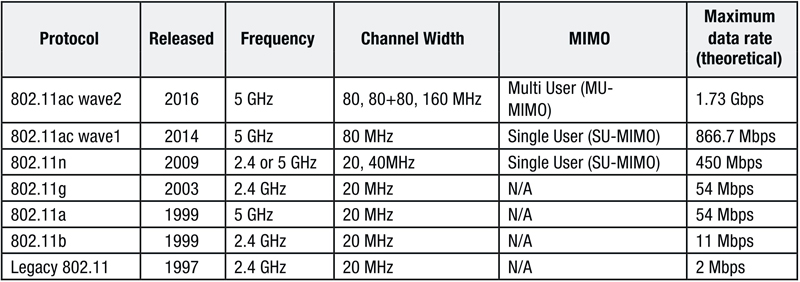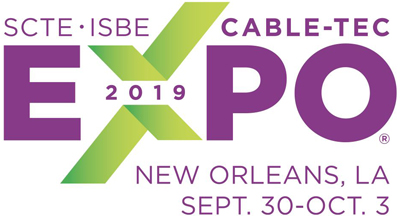The History of Wi-Fi and Emergence of Wi-Fi 6
By Chris Bastian
Where would we be without Wi-Fi, and specifically the IEEE 802.11 group of wireless standards? We have grown accustomed to our laptops and smart phones smoothly interoperating with thousands of Wi-Fi access points as we transit from place to place, supporting our video streaming, web browsing, and gaming needs. That dependence is only going to grow in the years ahead, as more and more IoT services become available, supporting such varied activities as remote health, education and more immersive gaming.
Is today’s Wi-Fi experience perfect? Not exactly, as users tend to complain about slow speeds, devices not connecting, or security concerns. It is, after all, wireless access across unlicensed spectrum, susceptible to subscriber over-concentration and interference. However, the Wi-Fi standards continue to evolve to improve the customer experience and alleviate these frustrations. The dawning of 802.11ax promises to bring faster speeds, better coverage in dense environments, greater security, and longer battery life.
Before we get into the latest Wi-Fi developments, let’s take a brief look at the history of the 802.11 standards:
The first 802.11 release was more than 20 years ago in 1997, and offered speeds up to 2 Mbps. Fast forward to today, when customers on the current 802.11ac standard can see speeds of more than 1 Gbps.
How does Wi-Fi consistently increase these offered speeds? Through a combination of allocating more bandwidth to the technology (growing from 1 MHz channels in the original 802.11 to up to 160 MHz in the latest 802.11ax specification), as well as by improving spectral efficiency and utilizing multiple input, multiple output, or MIMO.
Spectral efficiency
Spectral efficiency is a measure of how well a given access technology can transmit bits over a limited frequency spectrum, expressed as bits/sec/Hz. 802.11ax will provide four times the spectral efficiency of 802.11ac, and is achieving this by using orthogonal frequency division multiple access, or OFDMA, which reduces latency and has been used in cellular networks. 802.11ax also uses higher-order 1024-QAM. Quadrature amplitude modulation (QAM) uses both the phase and the amplitude of an RF signal to represent data bits.
MIMO
The “force multiplier” for recent Wi-Fi releases (since 11n) is MIMO. MIMO is a method of leveraging multipath propagation by using multiple transmit and receive antennas, to create simultaneous streams of data. Think of leveraging a multi-lane highway with multiple trucks, to carry your payload to the destination. Vendors conducting lab trials of the pending 802.11ax release are recording speeds of 3.5 Gbps over a single stream, which multiplies to over 14 Gbps when utilizing 4xMIMO.
The Wi-Fi present and near future
The evolution of Wi-Fi is not just about speed and capacity. To support new services such as IoT, the Wi-Fi standards are evolving to provide greater security, improved reliability and power efficiency, while preserving backward capability.
Security
Wi-Fi security is critically important to customers, especially when using public hotspots. The original 802.11 specification utilized WEP. By 2001, this level of security was deemed weak and quickly hackable, and was replaced by Wi-Fi Protected Access (WPA). While the 802.11ax release does not introduce enhanced security, it does require prerequisite support for the third generation of WPA, or WPA3. WPA3 provides 128-bit encryption for private use and optional 192-bit encryption for enterprises. It also supports “forward secrecy,” which provides protection for your traffic even if your Wi-Fi password becomes compromised. It is recommended that you always support the highest level of security that is interoperable with the devices within your network.
Power efficiency
802.11ax devices will have longer battery life, due to having the new feature target wake time (TWT). With TWT, the access point and device set schedules for when the device will wake up to send or receive data. This increases the device battery life and is an enabling feature for IoT.
Backward compatibility
As has been the case with previous Wi-Fi standards releases, 802.11ax will be backward compatible, at least back to the 802.11n standard, while supporting both the 2.4 GHz and 5 GHz bands (unlike 802.11ac, which only supported the 5 GHz band).
Wi-Fi PNM
Proactive network maintenance (PNM) is an operational support platform which constantly interrogates the network elements through MIBs and other data objects, looking for anomalies and predicting failures before they occur. Pioneered by CableLabs, the first instances of PNM addressed DOCSIS network operations. PNM is now also being applied to Wi-Fi. The growing presence of artificial intelligence and machine learning is also aiding the push to improve Wi-Fi operations using PNM. For more about PNM, see the Spring 2019 issue of Broadband Library at broadbandlibrary.com.
Simplifying Wi-Fi nomenclature
The longstanding naming of the 802.11 releases (802.11a, 11b, etc.) can be a bit confusing, so the Wi-Fi Alliance came up with simplified names:
• Devices which support 802.11n are now identified as Wi-Fi 4
• Devices which support 802.11ac are now identified as Wi-Fi 5
• Devices which support 802.11ax are now identified as Wi-Fi 6
The Wi-Fi Alliance certifies products that meet quality, performance, security, and capability standards, and advocates globally for fair spectrum rules.
Deployment tools
As new technology is rolled out, two things are critical to its successful introduction: that the new features and capabilities are easy to use by the customers, and that tools and training are available to the field technicians.
Here is a list of the most common customer-reported Wi-Fi issues, not specific to any 802.11 release (as listed in the SCTE Wi-Fi operational practice):
1. Lost Wi-Fi password or reset password requests (security)
2. Configuration of SSID (network name)
3. Range/coverage issues (proper AP placement)
4. Login/access to gateway/router
5. Slow or low speeds (closely related to range issues)
6. Intermittent wireless connections
7. Cannot connect wirelessly — all clients
8. Cannot connect wirelessly — single client
9. Customer does not know how to set up a Wi-Fi network
10. Customer is not familiar with setting up a new Wi-Fi client device
To address these problems, a two-pronged approach is recommended:
1. Customer education — Clear expectations should be set on how best to benefit from the new technology, such as which devices will be supported, how the access point should be located in the home or business, and what speeds and device densities can be realized. Customer-facing tools such as resetting their passwords, speed tests and home coverage maps should also be easy to use.
2. Field technician tools and training —
a. The field technician should be armed with a tutorial or online course which covers the new Wi-Fi standard’s features, and how to optimize the performance of the deployed access point(s), especially where to place the AP in the building.
b. Tools utilizing PNM: PNM is continuing to transform the way field technicians support services in the home. Instead of spending many minutes, if not hours manually troubleshooting a difficult issue, PNM can pinpoint issues and recommend resolutions before the technician even reaches the home.
Wi-Fi support through SCTE•ISBE activities
The SCTE•ISBE wireless working group released the above referenced “Operational Practice for Home Wi-Fi Deployment.” The intended audience for this practice is the group of installers, technicians and engineers who deploy residential Wi-Fi services. If you work in this area of the cable industry, consider joining the SCTE•ISBE Standards Program and participating in this active working group.
There will be a Wireless Access Network track at this year’s SCTE•ISBE Cable-Tec Expo®, September 30 – October 3 in New Orleans, LA. Presented topics will include Wi-Fi 6, 5G, CBRS, cable backhaul opportunities, and many more.
SCTE•ISBE offers courses, bootcamps and certifications for wireless professionals. Please visit https://www.scte.org/courses to learn more.
 Chris Bastian
Chris Bastian
SVP and CTO, SCTE•ISBE
Chris Bastian is responsible for ensuring that SCTE and ISBE maintain a leadership role in standardizing and operationalizing advanced technology, including the SCTE Standards Program and the SCTE Engineering Committee — as well as groundbreaking efforts such as SCTE’s Energy 2020 program. Prior to joining SCTE•ISBE, Chris spent 15 years with Comcast, ultimately becoming executive director of Comcast’s Xfinity Wi-Fi network. Previously, he also had worked with RCN and the National Security Agency. Chris and his family love camping, biking, hiking and other outdoor activities. The family vacation in 2015 was to Alaska, where they hiked in Denali National Park. In the summer of 2014, Chris and his son Ben hiked 120 miles at Philmont Scout Ranch in New Mexico. Highlights were hiking to the top of Mount Baldy (elev. 12,441 feet) and the Tooth of Time to catch the sunrise.

